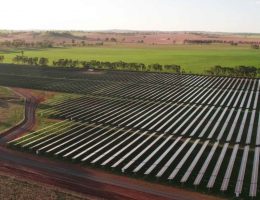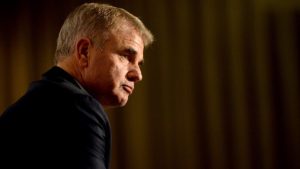It’s probably safe to say that prime minister Scott Morrison has never been this excited about a piece of wire strung between two poles.
Appearing at Ace Gutters on Monday, Morrison said he and “Gladys” (NSW Premier Gladys Berejiklian) were “getting things done” by investing in a “very big extension cord” to Queensland to bring power prices down and “keep the lights on”.
It sounded, as we wrote on Monday, like a pretty good idea, and a sign that the federal and state governments were finally alive to the need for more infrastructure investment, particularly transmission, to manage the huge influx of wind and solar power which the Coalition has tried to stop, but is happy to crow about, and the closure of coal fired power stations, which the Coalition is also keen to prevent and lament.
But, surprise, surprise, not is all what it seems with this announcement.
Morrison, along with who he called “Gladys”, and state energy minister Matt Kean, and his own under-fire energy minister Angus Taylor, all claimed that the $175 million investment in an upgraded link between NSW and Queensland, which the two governments will underwrite to the tune of $102 million, would lift capacity into NSW by 190MW.
“This will add 190MW of capacity to the New South Wales markets. And on the worst possible day, that can make the difference, that can make the difference between the lights going out and the lights staying on,” Taylor told a media briefing, according to the transcript on Morrison’s website.
That figure is a crucial one. 190MW is what was identified by the Australian Energy Market Operator as the need under its first order priorities in its crucial Integrated System Plan, its 20-year blueprint for the future. It is seen as crucial to help alleviate pressures on NSW grid, particularly after the exit of Liddell coal generator in early 2023.
The only problem is that the Transgrid proposal won’t deliver that 190MW of extra capacity, at least not when it is needed most – in the middle of a mid-summer heatwave when demand is at its peak and eight million people in NSW reach for their air-con units.
Transgrid’s favoured option, the one underwritten by Morrison and Berejiklian, will lift capacity by just 50MW in a typical summer day with medium demand, according to this summary table (above) included in documents tabled in its submissions and in a recent webinar.
The capacity can vary according to a number of factors such as ambient heat, demand, and what the 270MW Sapphire wind farm – the biggest installation on the QNI link between Queensland and NSW – is up to, and whether it is producing a lot, or not so much.
As it turns out, the funded upgrade to the QNI link only gets close to the 190MW capacity increase from Queensland to NSW – deemed so crucial to handle the troublesome summer peaks – in certain conditions, at night time, and in winter, and mostly if the Sapphire wind farm is not operating at full capacity.
 At night and in winter, when demand is considerably lower, the connector does have the capacity to significantly lift imports from Queensland (up to 240MW on some winter nights, see table above) and offer more competition and lower wholesale prices, but not so much at the times that Kean stated would be the “difference between blackouts and business as usual.”
At night and in winter, when demand is considerably lower, the connector does have the capacity to significantly lift imports from Queensland (up to 240MW on some winter nights, see table above) and offer more competition and lower wholesale prices, but not so much at the times that Kean stated would be the “difference between blackouts and business as usual.”
(See pages 78 through to 88 in this Transgrid document to see all the details).
If Morrison and Taylor really wanted to lock in 190MW on all occasions, including peak demand, perhaps they should have funded Transgrid’s Option 5B, which comprised two 200MW/100MWh batteries rather than a line upgrade, and would deliver a consistent 200MW increase in capacity, unaffected by temperature, demand and Sapphire wind farm.
That option was rejected by Transgrid because while it delivered much bigger “gross benefits’” than its favoured option, the higher capital costs of the battery reduced its net “present value” NPV to about 80c per person per year over 20 years, rather than $1.40 per person per year of its favoured option. And, given Morrison’s prior comments on big batteries, he’d probably prefer to invest in a Big Banana.
But, everyone can appear to be happy with Monday’s little big grid announcement. The federal government can look like it’s getting on with things and try and distract attention away from the woes of Taylor, facing scrutiny over grasslands and his extraordinary and ill-informed attack on City of Sydney mayor Clover Moore and her climate policies and travel expenses, which the police have been asked to investigate.
It’s also enabled the federal government to cosy up to NSW, and give Taylor hope of seeing at least one friendly face when he hosts in Perth next month his first meeting of the COAG energy ministers in nearly a year.
The last time he went, Taylor was isolated, and even the NSW Coalition dumped on him when its former energy minister expressed his frustration at the lack of a coherent climate policy, or even an energy strategy that did not involve a series of ad hoc interventions.
This November, Taylor will face pressure from all states. The main Labor states, Victoria and Queensland, are pursuing their own 50 per cent renewable energy targets by 2030. Ironically, it’s the Liberal states, South Australia and Tasmania, who have higher short term ambitions, and they are pushing new giant extension cords of their own.
Tasmania, already at 100 per cent renewables thanks to its hydro resources, wants to do more and tap into its considerable wind reserves and export this to Victoria. Taylor and Morrison have promised to help out Tasmania’s Marinus link to the mainland.
The renewable state of South Australia, at a world-leading 50 per cent plus share of wind and solar, aims for “net 100 per cent renewables” by 2030 and wants to be a clean energy exporter, again via a big new extension cord (750MW) to the eastern states. It is underwriting that project itself.
NSW has no such target, other than a vague long term pledge to be “zero emissions” by 2050. But it has a heap of coal fired generators about to retire, and will need to not only import cheap clean energy from its neighbours, but also build a lot of its own supply. Berijiklian says it has 17GW of renewables in the queue, but it needs more poles and wires to connect them.
Kean, on ABC Radio on Tuesday, lamented the fact that the “climate wars” had held back investment in both generation and transmission. Guess who’s responsible for the climate wars? Maybe the $51 million contribution from the feds will be enough to buy his co-operation in November. Time will tell.
Transgrid, though, is happy. The underwriting agreement means that even if its favoured proposal is rejected by the lengthy and complex regulatory process over the next 12-18 months, it is guaranteed the state and federal governments’ $102 million to make up any spending it has committed till then.
How good is that?











